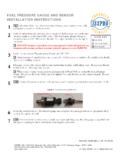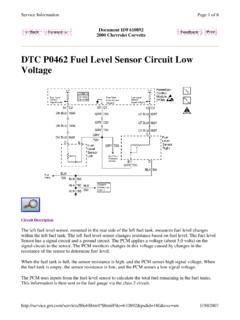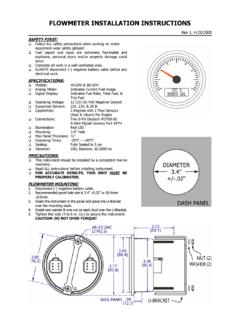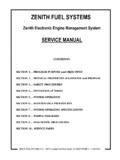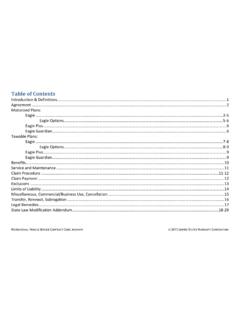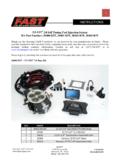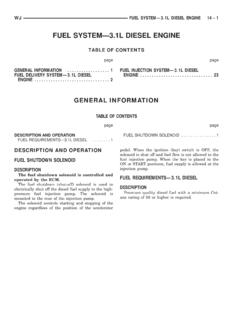Transcription of Volkswagen Cabriolet DIY Guide - Cabby Info
1 2015 KamzKreationz Page 1 of 15 K-lambda Adjustments Volkswagen Cabriolet DIY Guide K-Jetronic: Measuring Duty Cycle, Adjusting Air-Fuel Mixture, & Setting Idle Overview Before doing anything, let's discuss what CIS, K-Jetronic, lambda, and duty cycle are so that you get a very basic understanding of how the system works and what it is you'll be testing. K-Jetronic is a mechanical fuel injection system developed by Bosch in the 1970s and is used in a wide variety of vehicles around the world. K-Jetronic is a continuous injection system (CIS), which means that the fuel injectors receive and produce a constant flow of fuel, provided there is proper pressure, whenever the engine is running.
2 CIS is a mechanical injection system because fuel is metered by the mechanical link between the fuel distributor and airflow sensor plate, which are linked together in one housing. In other words, fuel is metered in proportion to the incoming air flow. In order to adhere to stricter emissions requirements in North America, Bosch enhanced K-Jetronic by adding lambda control. With the addition of an oxygen sensor (aka lambda probe) feedback system, K-Jetronic's air-fuel mixture can be more precisely controlled while the engine is running under various conditions (cold, warm, full-throttle). K-lambda (as it's often referred to) has better emissions, in theory, than its basic predecessor.
3 It is called lambda because Bosch uses the Greek letter lambda ( ) to represent the stoichiometric ratio ( :1) of the air-fuel mixture the system strives to achieve for peak operating performance. When the engine is warmed up, the oxygen sensor produces an electrical signal based on the oxygen content in the exhaust that is sent to the Jetronic control unit under the dash. This control unit takes the oxygen sensor's voltage, converts it to a square wave signal (a pulsed 100 Hz on/off ground signal), and sends that signal to the frequency valve (aka lambda valve, an injector of sorts), which determines the amount of time the valve is open.
4 That pulsed ground signal is the lambda system's duty cycle. The valve's on/off behavior is what creates the audible buzzing (reminder: if the frequency valve does not buzz/vibrate, there is something wrong). Note: The frequency valve does not meter fuel, but, rather, controls the fuel distributor's lower chamber fuel pressure, which, in turn, changes upper chamber pressure to vary fuel enrichment. The photos above show two lambda system duty cycles as produced by oscilloscopes. The left photo depicts a system that is being enriched while the vehicle is being driven; the right photo shows a system at approximately 50%.
5 While it is often called an electronic control unit, the Jetronic controller is not a computer and should never be referred to as such. Because this control unit is analog and merely processes and reroutes voltage signals, it is very wrong to refer to K-lambda as an electronic fuel it is not an electronic fuel system! While the frequency valve operates based on an electronic voltage signal, the air-fuel mixture still takes place mechanically inside the fuel distributor as described above. The K-Jetronic lambda controller installed in Volkswagen Cabriolets (and Rabbits, Golfs, Sciroccos, and a host of other vehicles) consists of nothing more than a circuit board with a bunch of capacitors, inductors, resistors, transistors, and diodes.
6 As you can see from the photo at left, the controller is really nothing more than a relay (of sorts) on steroids. The basic stages of the lambda system: 1. Open loop - cold: Engine is cold-started, thus providing cold-running enrichment during warm-up period. 2. Open loop - warm: Cold enrichment has ended; system is at 50% duty cycle, waiting for oxygen sensor activity; also known as limp-home mode. 3. Closed loop: Oxygen sensor is sufficiently heated and is now sending voltage signals to control unit during the engine's warm running period. 4. Open loop - WOT: Full-throttle (aka wide-open throttle) switch has been activated, providing fuel enrichment override.
7 Photos by Myndex (l.) and Walt Fricke (r.) from forum. Photo by Myndex from forum. 2015 KamzKreationz Page 2 of 15 K-lambda Adjustments While the pulsed ground signal sent from the oxygen sensor control unit to the frequency valve is a square wave valued on a 100 Hertz (Hz) frequency scale (with spikes up to 12,000), this voltage signal is measured in duty cycle (0-100%), or in dwell (0-90 ). This information is used to adjust, if need be, the air-fuel mixture on a K-lambda car. Here's how the system works (provided everything is functioning as it should): 1.
8 If you start the car when the engine temperature is cold, the oxygen sensor thermoswitch closes and sends a signal to the control unit. 2. The control unit, in turn, sends a fixed 80% duty cycle (65% for 1988+) signal to the frequency valve. That fixed cold-running enrichment signal (80% or 65%) remains in place until the coolant reaches a specific temperature (25 C or 45 C, depending on the thermoswitch installed in your car). 3. The thermoswitch then opens, cutting its signal to the control unit. If the oxygen sensor is not at its operating temperature when the thermoswitch opens, the system reverts to warm open loop, or limp-home mode (50%).
9 4. Once the oxygen sensor is heated to its proper temperature, it sends a signal to the control unit and the system enters closed loop, or its normal regulating function (50% 8% duty cycle). Should the full-throttle switch be activated, closed-loop is overridden for forced full-throttle enrichment (65% duty cycle). Up through and including the 1987 model year, cold-running enrichment (80%) overrides full-throttle enrichment (65%). From the 1988 model year onward, cold-running enrichment does not override full-throttle enrichment because the two values are the same (65%). "Open loop will also happen when the car has been parked briefly, the oxygen sensor has cooled off, and the thermoswitch hasn't closed; upon restarting, it takes a minute or more before the oxygen sensor heats enough to produce a signal and send the system into closed loop.
10 That's why oxygen sensors are now heated; they start working faster, systems go into closed-loop sooner. "There isn't always an open-loop stage during warm-up. If the engine is cold (real cold, like winter in Montana cold), and the oxygen sensor is in great shape, the oxygen sensor's heater and the exhaust heat may get the oxygen sensor up to operating temperature before the thermoswitch warms enough from from the coolant to open. In that sort of circumstance, the system will go straight from cold-running enrichment to closed-loop; no open-loop transition at all. Same car, same cold weather: The oxygen sensor will cool quickly when the car is parked, while the coolant will retain heat much longer; on restart, there will be no cold-running enrichment -- the system will be in open-loop until the oxygen sensor warms up enough to put the system into closed-loop.

